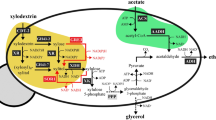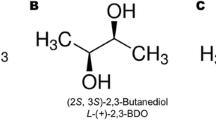Abstract
Production of renewable fuels and chemicals from cellulosic biomass is a critical step towards energy sustainability and reduced greenhouse gas emissions. Microbial cells have been engineered for producing chemicals from cellulosic sugars. Among these chemicals, 2,3-butanediol (2,3-BDO) is a compound of interest due to its diverse applications. While microbial production of 2,3-BDO with high yields and productivities has been reported, there are concerns associated with utilization of potential pathogenic bacteria and inefficient utilization of cellulosic sugars. To address these problems, we engineered 2,3-BDO production in Saccharomyces cerevisiae, especially from cellobiose, a prevalent sugar in cellulosic hydrolysates. Specifically, we overexpressed alsS and alsD from Bacillus subtilis to convert pyruvate into 2,3-BDO via α-acetolactate and acetoin in an engineered cellobiose fermenting S. cerevisiae. Under oxygen-limited conditions, the resulting strain was able to produce 2,3-BDO. Still, major carbon flux went to ethanol, resulting in substantial amounts of ethanol produced as a byproduct. To enhance pyruvate flux to 2,3-BDO through elimination of the pyruvate decarboxylation reaction, we employed a deletion mutant of both PDC1 and PDC5 for producing 2,3-BDO. When a cellobiose utilization pathway, consisting of a cellobiose transporter and intracellular β-glucosidase, and the 2,3-BDO producing pathway were introduced in a pyruvate decarboxylase deletion mutant, the resulting strain produced 2,3-BDO without ethanol production from cellobiose under oxygen-limited conditions. A titer of 5.29 g/l 2,3-BDO with a productivity of 0.22 g/l h and yield of 0.29 g 2,3-BDO/g cellobiose was attained. These results suggest the possibility of producing 2,3-BDO safely and sustainably from cellulosic hydrolysates.




Similar content being viewed by others
References
Adachi E, Torigoe M, Sugiyama M, Nikawa J-I, Shimizu K (1998) Modification of metabolic pathways of Saccharomyces cerevisiae by the expression of lactate dehydrogenase and deletion of pyruvate decarboxylase genes for the lactic acid fermentation at low pH value. J Ferment Bioeng 86(3):284–289
Atsumi S, Li Z, Liao JC (2009) Acetolactate synthase from Bacillus subtilis serves as a 2-ketoisovalerate decarboxylase for isobutanol biosynthesis in Escherichia coli. Appl Environ Microbiol 75(19):6306–6311
Bae YH, Kang KH, Jin YS, Seo JH (2014) Molecular cloning and expression of fungal cellobiose transporters and beta-glucosidases conferring efficient cellobiose fermentation in Saccharomyces cerevisiae. J Biotechnol 169:34–41. doi:10.1016/j.jbiotec.2013.10.030
Bar-Even A, Tawfik DS (2013) Engineering specialized metabolic pathways—is there a room for enzyme improvements? Curr Opin Biotechnol 24:310–319
Bohlin C, Praestgaard E, Baumann M, Borch K, Praestgaard J, Monrad R, Westh P (2013) A comparative study of hydrolysis and transglycosylation activities of fungal β-glucosidases. Appl Microbiol Biotechnol 97(1):159–169. doi:10.1007/s00253-012-3875-9
Christensen CH, Rass-Hansen J, Marsden CC, Taarning E, Egeblad K (2008) The renewable chemicals industry. ChemSusChem 1(4):283–289
Flikweert M, Van Der Zanden L, Janssen W, Steensma H, Van Dijken J, Pronk J (1996) Pyruvate decarboxylase: an indispensable enzyme for growth of Saccharomyces cerevisiae on glucose. Yeast 12(3):247
Flikweert MT, Swaaf M, Dijken JP, Pronk JT (1999) Growth requirements of pyruvate decarboxylase negative Saccharomyces cerevisiae. FEMS Microbiol Lett 174(1):73–79
Galazka JM, Tian C, Beeson WT, Martinez B, Glass NL, Cate JH (2010) Cellodextrin transport in yeast for improved biofuel production. Science 330(6000):84–86
Garg S, Jain A (1995) Fermentative production of 2,3-butanediol: a review. Bioresour Technol 51(2):103–109
González-Ramos D, van den Broek M, van Maris AJ, Pronk JT, Daran J-MG (2013) Genome-scale analyses of butanol tolerance in Saccharomyces cerevisiae reveal an essential role of protein degradation. Biotechnol Biofuels 6(1):48
Ha S-J, Galazka JM, Kim SR, Choi J-H, Yang X, Seo J-H, Glass NL, Cate JH, Jin Y-S (2011) Engineered Saccharomyces cerevisiae capable of simultaneous cellobiose and xylose fermentation. Proc Natl Acad Sci U S A 108(2):504–509
Ha S-J, Galazka JM, Oh EJ, Kordic V, Kim H, Jin Y-S, Cate JH (2012) Energetic benefits and rapid cellobiose fermentation by Saccharomyces cerevisiae expressing cellobiose phosphorylase and mutant cellodextrin transporters. Metab Eng
Hohmann S, Cederberg H (1990) Autoregulation may control the expression of yeast pyruvate decarboxylase structural genes PDC1 and PDC5. Eur J Biochem 188(3):615–621
Hosaka K, J-i N, Kodaki T, Yamashita S (1992) A dominant mutation that alters the regulation of INO1 expression in Saccharomyces cerevisiae. J Biochem 111(3):352–358
Jansen NB, Flickinger MC, Tsao GT (1984) Production of 2, 3-butanediol from d-xylose by Klebsiella oxytoca ATCC 8724. Biotechnol Bioeng 26(4):362–369
Kim S-J, Seo S-O, Jin Y-S, Seo J-H (2013) Production of 2,3-butanediol by engineered Saccharomyces cerevisiae. Bioresour Technol 146:274–281. doi:10.1016/j.biortech.2013.07.081
Kondo T, Tezuka H, Ishii J, Matsuda F, Ogino C, Kondo A (2012) Genetic engineering to enhance the Ehrlich pathway and alter carbon flux for increased isobutanol production from glucose by Saccharomyces cerevisiae. J Biotechnol 159(1):32–37
Lee W-H, Nan H, Kim HJ, Jin Y-S (2013) Simultaneous saccharification and fermentation by engineered Saccharomyces cerevisiae without supplementing extracellular β-glucosidase. J Biotechnol 167(3):316–322. doi:10.1016/j.jbiotec.2013.06.016
López J, Thoms B, Rehbein H (1975) Acetoin degradation in Bacillus subtilis by direct oxidative cleavage. Eur J Biochem 57(2):425
Ma C, Wang A, Qin J, Li L, Ai X, Jiang T, Tang H, Xu P (2009) Enhanced 2,3-butanediol production by Klebsiella pneumoniae SDM. Appl Microbiol Biotechnol 82(1):49–57
Ng CY, M-y J, Lee J, Oh M-K (2012) Production of 2, 3-butanediol in Saccharomyces cerevisiae by in silico aided metabolic engineering. Microb Cell Fact 11:68
Oh EJ, Ha S-J, Kim SR, Lee W-H, Galazka JM, Cate JH, Jin Y-S (2013) Enhanced xylitol production through simultaneous co-utilization of cellobiose and xylose by engineered Saccharomyces cerevisiae. Metab Eng 15:226–234
Pronk JT, Steensma HY, Van Dijken JP (1996) Pyruvate metabolism in Saccharomyces cerevisiae. Yeast 12(16):1607–1633
Rutter C, Chen R (2014) Improved cellobiose utilization in E. coli by including both hydrolysis and phosphorolysis mechanisms. Biotechnol Lett 36(2):301–307. doi:10.1007/s10529-013-1355-7
Serrano-Ruiz JC, West RM, Dumesic JA (2010) Catalytic conversion of renewable biomass resources to fuels and chemicals. Annu Rev Chem Biomol Eng 1:79–100
Shin H-D, Yoon S-H, Wu J, Rutter C, Kim S-W, Chen RR (2012) High-yield production of meso-2,3-butanediol from cellodextrin by engineered E. coli biocatalysts. Bioresour Technol 118:367–373
Syu M-J (2001) Biological production of 2,3-butanediol. Appl Microbiol Biotechnol 55(1):10–18
van Maris AJ, Luttik MA, Winkler AA, van Dijken JP, Pronk JT (2003) Overproduction of threonine aldolase circumvents the biosynthetic role of pyruvate decarboxylase in glucose-limited chemostat cultures of Saccharomyces cerevisiae. Appl Environ Microbiol 69(4):2094–2099
van Maris AJ, Geertman J-MA, Vermeulen A, Groothuizen MK, Winkler AA, Piper MD, van Dijken JP, Pronk JT (2004) Directed evolution of pyruvate decarboxylase-negative Saccharomyces cerevisiae, yielding a C2-independent, glucose-tolerant, and pyruvate-hyperproducing yeast. Appl Environ Microbiol 70(1):159–166
Zelle RM, de Hulster E, van Winden WA, de Waard P, Dijkema C, Winkler AA, Geertman J-MA, van Dijken JP, Pronk JT, van Maris AJ (2008) Malic acid production by Saccharomyces cerevisiae: engineering of pyruvate carboxylation, oxaloacetate reduction, and malate export. Appl Environ Microbiol 74(9):2766–2777
Acknowledgements
This work was supported by funding from the Energy Biosciences Institute. H.N. was supported by the Jeannette Chu and Winston Lo Endowed Fellowship from the Department of Food Science and Human Nutrition, University of Illinois, Urbana, IL.
Author information
Authors and Affiliations
Corresponding author
Rights and permissions
About this article
Cite this article
Nan, H., Seo, SO., Oh, E.J. et al. 2,3-Butanediol production from cellobiose by engineered Saccharomyces cerevisiae . Appl Microbiol Biotechnol 98, 5757–5764 (2014). https://doi.org/10.1007/s00253-014-5683-x
Received:
Revised:
Accepted:
Published:
Issue Date:
DOI: https://doi.org/10.1007/s00253-014-5683-x




